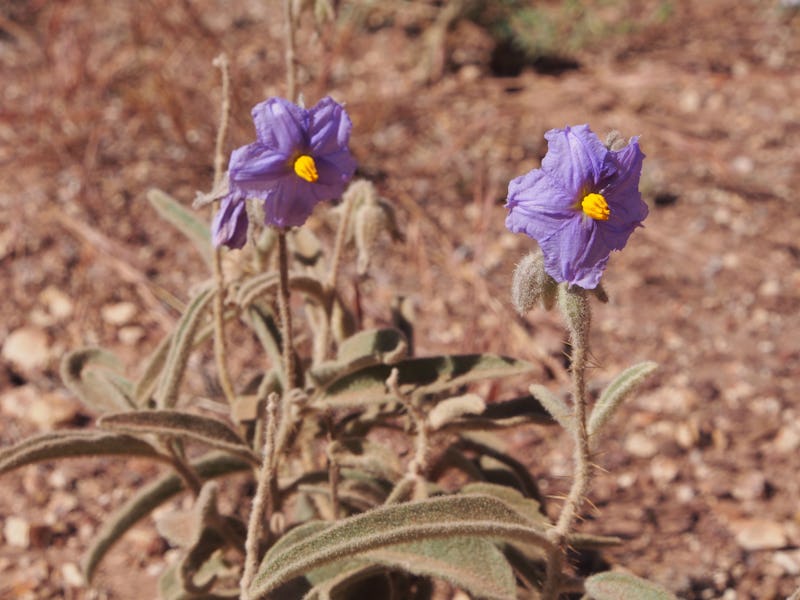"Bush Tomato": A "Confusing" Plant Species Has Defied Sexuality Definitions
"What we ought to consider 'normative' is really a vast and fascinating set of possibilities."

Strange things grow in Australia’s Northern Territory, the deserted, red-streaked expanse at the continent’s upper limit. A flowering plant discovered there by the botanist Peter Latz in 1974 was especially perplexing. “This has me puzzled also,” he wrote. “I have not seen its like before, but think it some variant or aberrant.” For decades, the plant, which seemed to eschew binary sexuality, made no sense to researchers.
"This species, for reasons we don’t yet understand, moves among three different types of sexual expression."
But as Bucknell University scientists suggested in a paper published Tuesday, perhaps it was our definition of sexuality that was too narrow.
In the paper, published in the journal PhytoKeys, they reveal that the flowering plant that perplexed Latz and so many other scientists is a new species of “bush tomato” with unconventional sexuality. They named it Solanum plastisexum to acknowledge its sexual plasticity.
“This species, for reasons we don’t yet understand, moves among three different types of sexual expression: plants that are male, plants that are bisexual, and plants that are, more or less, both things,” co-study lead Chris Martine, Ph.D., a professor of plant genetics, tells Inverse.
Australia's Northern Territory is large and arid, with red-tinged soil.
In an effort to find and characterize the plant Latz encountered so many years ago, he and co-lead author Angela McDonnell, Ph.D., returned to the Australian bush with their colleagues to collect it and take a closer look. Their discovery, Martine says, drives home the idea that sexuality in nature isn’t strictly binary.
“The truth is that what we ought to consider ‘normative’ is really a vast and fascinating set of possibilities,” he says.
“Three Types of Expression”
The sexual organs of a plant live inside its flowers. The male organ is the stamen, the thin tube that stretches upward and is capped with a ball of pollen (plant “sperm”). The female organ is the tall pistil in the middle of the blossom, which captures pollen (sometimes from other plants, sometimes its own) and brings it down to the plant ovaries at the base of the flower, where seeds are born after fertilization.
In most plant species, individual plants are either bisexual (meaning they have both organs in one flower) or clearly male or female. This species of bush tomato is a little different. All of the notes left behind by previous botanists who studied it mentioned how confusing it was that individual plants could have flowers that were either all male, all bisexual, or male and bisexual.
Their work was left unfinished since they could not figure out what to make its sexuality and what existing species it belonged to. Martine and McDonnell realized it was a new species with a new mode of sexual expression.
In a flower, male stamens are like arms holding bundles of pollen in the air; the female pistil, standing tall in the middle, brings pollen down a tube leading to the ovaries.
“The baseline expression that this species is ‘supposed’ to have is already unusual because its closest relatives always have a combination of male and bisexual flowers on the same plant,” says Martine. “This species does that, for sure, but we also run into individuals that are either just male or just bisexual.”
“So it is moving among three types of expression, whereas most species just stick with one,” he continues. Once the time came to define this new species, he and McDonnell did something unique: Rather than fit it into a traditional category of plant sexuality, they accepted that it simply had a different way of existing.
“So when we couldn’t quite nail this one down, it was confusing — but also intriguing because it’s never really been that way for any of the species that we study,” says Martine.
S. plastisexum individuals can be male, female, or bisexual.
Fluidity in Nature
Fascinating as this discovery is, sexual fluidity is not a new concept in biology. Sexual expression beyond a binary male/female system exists in many species, as the natural occurrence of hermaphrodites, gynandomorphs, asexual animals, and many others show.
"I’d say it’s a fool’s errand to even try."
“The scientific literature is chock full of examples of sexual fluidity in nature, partly because the reproductive form of organisms is central to understanding their biology,” explains Martine. “We’ve paid close attention to this stuff for centuries.”
It’s tricky to draw a parallel between sexual fluidity in plants and humans because human sexuality is complicated by the concept of gender, whereas only the physical aspects of sex apply to plants. Nevertheless, S. plastisexum is a reminder that sex can manifest physically in many different ways — sometimes ways we didn’t even know were possible.
“There is no easy way to define what sexual expression among the Earth’s organisms should look like,” says Martine. “I’d say it’s a fool’s errand to even try.”